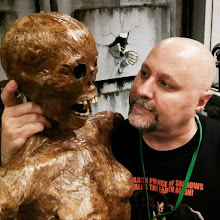 |
| Walter Starkie portrait by Eduardo Chicharro Briones (1948) |
The first book details his adventures throughout Hungary and Romania; in Chapter IV, Starkie speaks of Magyar superstitions, and relates the sad story of an old man who's family was destroyed by a vampire. The tale itself--simply titled "The Old Man's Story"--at times almost hints of Dracula. So one has to wonder: was this truly a tale told to him by firelight, in the middle of a graveyard somewhere on the road to Budapest? Or did Starkie enhance the story based on other vampire tales that he may have read?
On the night this story takes place, Starkie was determined to sleep outdoors, because he was amazed by how the parched meadows and dusty roads by daylight became such a dreamscape at night. He writes, "In the moonlight, the fields of corn, the clumps of trees, the little knolls here and there become meeting-places of fairies." He then decides to sleep at the foot of a small cemetery, which was nestled "peacefully in the moonlight." (I find cemeteries quite peaceful myself, but only in the light of day!) Shortly after making a small bonfire, he starts to question his decision, as thoughts of vampires and werewolves flood his mind. A bat suddenly swoops past his face, which leads to thoughts of Dracula; needless to say, he has difficulty sleeping. Here's how he sets up meeting the old man:
I awoke suddenly at the sound of a dog yelping nearby. When I looked up above my tombstone I saw at the other side of the cemetery a light burning over one of the graves. For a moment I thought that I was still wandering through the halls of sleep, but then the horrible thought struck me that I might have been unlucky enough to enter a vampire-haunted graveyard ... I then saw that it was a small lantern carried by an old man who was hobbling on a stick and tugging after him at the end of a rope the dog I had heard yelping. He was a strange little old man, like one of the goblins in Grimm's fairy stories.
The man first speaks in Magyar, but after Starkie replies in German, he switches to that language--and warns that a nearby tomb is haunted by a nachtoeher (which may actually be the German word nachtmahr, meaning "nightmare"). The man then points to two holes on a nearby tombstone, which he claims is a sign that the grave is inhabited by a vampire--and wonders why Starkie hasn't used garlic to stop up the holes (which prevents such "foul demons" from getting out). "I tell you," he adds, "no one can escape those vampires once they begin to go after you. I have striven for years to escape their visitation, but they have taken everything I have in this world and they would take me were it not for my prayers."
By this point, Starkie has deftly set up a fitting atmosphere for the old man's story. I don't want to give too much away, but here's how it begins: The old man's only son, Sándor, returned from Army service one day with a stranger whom he described as his benefactor, and on more than one occasion had paid his debts and lavished money on him. The family welcomed the man, who soon looked upon their house as his own. It wasn't long before the old man began to notice his son's infatuation with the stranger (who was twenty years older), and was struck by how he monopolized Sándor's attention:
"The stranger had something Mephistophelian about his appearance: he was tall and thin, with aquiline features and a small pointed beard. His eyes were strained and had a wild look in them like those of a cigány [Gypsy]: his mouth was coarse and brutal, with very red lips, and when he spoke he would frequently lick them and show his teeth, which were brilliantly white and sharply pointed like those of a dog or wolf."
The old man later adds that the stranger had "long white fingers like those of a woman, with sharp nails cut to a point." Here is how Stoker describes Dracula (edited for brevity):
"His face was a strong--a very strong--aquiline, with high bridge of the thin nose and peculiarly arched nostrils ... The mouth, so far as I could see it under the heavy moustache, was fixed and rather cruel-looking, with peculiarly sharp white teeth; these protruded over the lips, whose remarkable ruddiness showed astonishing vitality in a man of his years. For the rest, his ears were pale, and at the tops extremely pointed; the chin was broad and strong, and the cheeks firm though thin ... I had noticed the backs of his hands as they lay on his knees in the firelight, and they had seemed rather white and fine; but seeing them now close to me, I could not but notice that they were rather coarse--broad, with squat fingers. Strange to say, there were hairs in the centre of the palm. The nails were long and fine, and cut to a sharp point."
The old man's eldest daughter, Julcsa, became enthralled by the stranger, at times almost hypnotized by his stories of travel and adventure. His wife, however, remained wary of him, and worried that he'd seduce the girl then run off in the middle of the night "like a thief." She was right to be concerned; one foggy night, inside a carriage drawn by four black horses, the stranger and Julcsa ran away together. Months later, brokenhearted, the old man's wife passed away--and his son left home. After a time, Sándor became seriously ill. He was struck with consumption (tuberculosis), and often had strange dreams of his missing sister:
"He dreamt he met her outside the arched gate of a city and she stood within the arch and beckoned to him to enter. She was dressed in dazzling white and looked radiantly beautiful and happy, but her face was as white as her dress and her lips were like a scarlet wound ... Then he awoke in a state of terrible anguish, and he felt so weak that he thought he was going to die."
This passage hints of Dracula, as well as the legend of the White Lady and the Slavic rusalka. I could elaborate, but I'd rather you, dear reader, experience the story first-hand and draw your own conclusions. Raggle-Taggle is available at a great number of libraries (and "The Old Man's Story" has been summarized here).
One contemporary reviewer was generally skeptical of Starkie's travel accounts. In The Saturday Review, Konbad Bercovzci noted that the author "has little difficulty in earning his living playing for the peasants and the villagers, where the native gypsy starves so often. The gypsies receive him everywhere, or almost everywhere, with open arms though they don't understand what he says to them. Yet he manages not only to entrance them with his stories, but manages to extract long stories from them and to quote proverbs (and quote them exactly) in both Hungarian and Rumanian. Really, the professor works miracles." Another review, in the Toronto Daily Star, took everything Starkie wrote as gospel: "It is the music and the dance that hits the splendors of this road-roaming romance. The book is a continuous crescendo of emotional scenes...[and] explains grotesquely the legend of the werewolf as told to the author in a graveyard where he slept, by an old man whose wife and family had been blood victims of a Dracula."
 |
| Toronto Daily Star, April 1931 |
It's also interesting that the reviewer describes the creature as a werewolf, whereas Starkie only uses the term vampire in the old man's tale. This could be a simple mix up, since I've uncovered many early uses of 'vampire' in print within Canada, going as far back as 1855. That year, in The Globe, an article described superstitions among European peasants, noting that vampires "descend into their graves with their eyes open, and rise at dead of night to suck the blood of their victims, leaving no trace behind except a little spot on the neck or throat." These examples show that both 'Dracula' and 'vampire' were in common enough usage by the early 1930s.
But enough of my musing about the Canadian lexicon. To my original point: was Starkie's account of the old man's story in fact an amalgam of whispers and superstitions that he heard during his travels, enhanced by ideas that he may have read elsewhere (such as in Dracula)? Or was this truly a personal story told to him by an elderly Romani in the middle of the night, outside a tomb in a rustic graveyard somewhere on the road to Budapest? I vote for the latter, because it makes for a good story (despite the tragedy to those involved)--and Raggle-Taggle itself is a memorable read.











0 comments:
Post a Comment